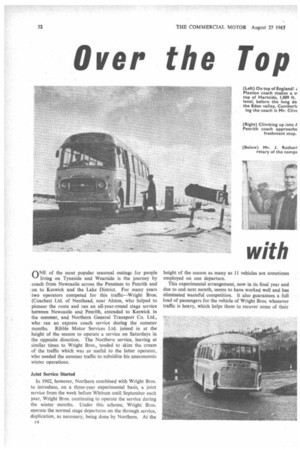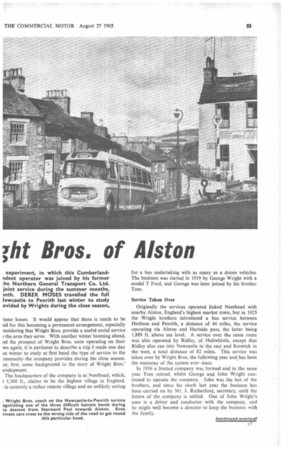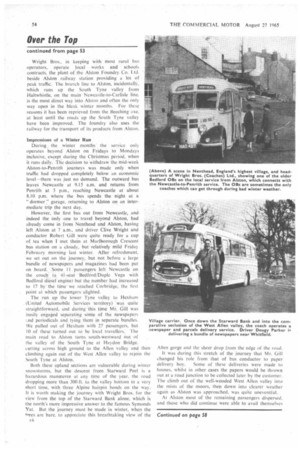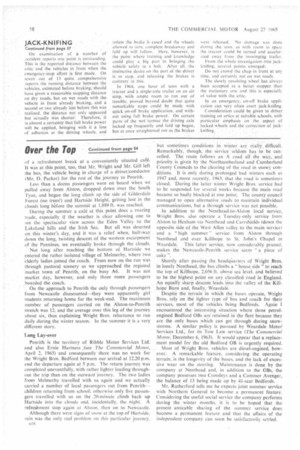Over the Top
Page 54

Page 55

Page 56

Page 60

If you've noticed an error in this article please click here to report it so we can fix it.
with
?ihiBros. of Alston n NE of the most popular seasonal outings for people living on Tyneside and Wearside is the journey by coach from Newcastle across the Pennines to Penrith and on to Keswick and the Lake District. For many years two operators competed for this traffic—Wright Bros. (Coaches) Ltd. of Nenthead, near Alston, who helped to pioneer the route and ran an all-year-round stage service between Newcastle and Penrith, extended to Keswick in the summer, and Northern General Transport Co. Ltd., who ran an express coach service during the summer months. Ribble Motor Services Ltd. joined in at the height of the season to operate a service on Saturdays in the opposite direction. The Northern service, leaving at similar times to Wright Bros., tended to skim the cream of the traffic which was so useful to the latter operator, who needed the summer traffic to subsidize his uneconomic winter operations.
Joint Service Started In 1962, however, Northern combined with Wright Bros. to introduce, on a three-year experimental basis, a joint service from the week before Whitsun until September each year, Wright Bros. continuing to operate the service during the winter months. Under this scheme, Wright Bros. operate the normal stage departures on the through service, duplication, as necessary, being done by Northern. At the c4 height of the season as many as 11 vehicles are sometimes employed on one departure.
This experimental arrangement, now in its final year and due to end next month, seems to have worked well and has eliminated wasteful competition. It also guarantees a full load of passengers for the vehicle of Wright Bros. whenever traffic is heavy, which helps them to recover some of their inter losses. It would appear that there is much to be kid for this becoming a permanent arrangement, especially ansidering that Wright Bros. provide a useful social service ) the area they serve. With another winter looming ahead, ad the prospect of Wright Bros. soon operating on their wn again, it is pertinent to describe a trip I made one day Lst winter to study at first hand the type of service to the Dmmunity the company provides during the close season. ut, first, some background to the story of Wright Bros.' evelopment.
The headquarters of the company is at Nenthead, which, t 1,500 ft., claims to be the highest village in England. , is certainly a rather remote village and an unlikely setting for a bus undertaking with as many as a dozen vehicles. The business was started in 1919 by George Wright with a model T Ford, and George was later joined by his brother Tom.
Service Taken Over Originally the services operated linked Nenthead with nearby Alston, England's highest market town, but in 1925 the Wright brothers introduced a bus service between Hexham and Penrith, a distance of 44 miles, the service operating via Alston and Hartside pass, the latter being 1,889 ft. above sea level. A service over the same route was also operated by Ridley, of Haltwhistle, except that Ridley also ran into Newcastle in the east and Keswick in the west, a total distance of 82 miles. This service was taken over by Wright Bros. the following year and has been the mainstay of the system ever since.
In 1936 a limited company was formed and in the same year Tom retired, whilst George and John Wright continued to operate the company. John was the last of the brothers, and since his death last year the business has been carried on by Mr. J. Rutherford, secretary, until the future of the company is settled. One of John Wright's sons is a driver and conductor with the company, and he might well become a director to keep the business with the family.
Wright Bros.. in keeping with most rural bus operators, operate local works and schools contracts, the plant of the Alston Foundry Co. Ltd. beside Alston railway station providing a lot of peak traffic. The branch line to Alston, incidentally, which runs up the South Tyne valley from Haltwhistle, on the main Newcastle-to-Carlisle line. is the most direct way into Alston and often the only way open in the bleak winter months. For these reasons it has been reprieved from the Beeching axe. at least until the roads up the South Tyne valley have been improved. The foundry also uses the railway for the transport of its products from Alston.
Impressions a a Winter Run During the winter months' the serviceonly operates beyond Alston on Fridays to Mondays inclusive,, except during the Christmas period, when it runs daily_ The decision to withdraw the 'mid-week Alston-to-Penrith journeys was made only when traffic had dropped completely below an economic level—there was just no demand. The outward bus leaves Newcastle at 9.15 a.m. and returns from Penrith at 5 p.m., reaching Newcastle at about 8.10 p.m. where the bus spends the night at a " dormer!' garage, returning to Alston on an intermediate trip the next day.
However, the first bus out from Newcastle, and indeed the 'only one to travel beyond Alston, had already come in from Nenthead and Alston, having left Alston at 7 a.m., and driver Clive Wright and conductor Robert Gill were quite ready for a cup of tea when I met theM at Marlborough Crescent bus station on a cloudy, but relatively mild Friday February morning last winter. After refreshment, we set out on the journey, but not before a large bundle of newspapers and magazines had been put on board._ 'Some. 11 'passengers left, Newcastle on the coach_ (a 41-seat. -Bedford/Duple Vega with Bedford dieSel engine) but the number had increased to 17 by the time we reached Corbridge. the first point at which passengers alighted.
The run up the lower Tyne valley to Hexham (United Automobile Services territory) was quite straightforward, and during -this time yr. dill was busily engaged separating some of the newspapers :-,nd periodicals and, tying them in separate bundles. We pulled out of Hexham with 27 passengers. but 10 of these turned out to be local travellers.. The main road to Alston turns south-westward out of the valley of the South Tyne at Haydon Bridge. cutting across high ground to the Allen valley and then climbing again out of the West Allen valley to rejoin the South Tyne at Alston.
Both these upland sections are vulnerable during winter snowstorms, hut the descent from Starward Peel is a hazardous manceuvre at any time of the year, the road dropping more than 300 ft. to the valley bottom in a very short time, with three Alpine hairpin bends on the way. It is worth making the journey with Wright Bros. for the view from the top of the Starward Bank alone, which is the north's more impressive answer to the famous Symonds Yat. But the journey must be made in winter, when the trees are bare, to appreciate this breathtaking view of the (-6
Allen gorge and the sheer drop from the edge of the road. It was during this stretch of the journey that Mr. Gill changed his role from that of bus conductor to paper
delivery boy. Some of these deliveries were made to houses, whilst in other cases the papers would be thrown out at a road junction to be collected later by the customer. The climb out of the well-wooded West Allen valley into the mists of the moors, then down into clearer weather again as Alston was approached, was quite uneventful.
At Alston most of the remaining passengers dispersed. and those who did continue were able to avail themselves
of a refreshment break at a conveniently situated café. It was at this point, too, that Mr. Wright and Mr. Gill left the bus, the vehicle being in charge Of a driver/conductor (Mr. D. Parker) for the rest of the journey to Penrith. Less than a dozen passengers were on board when we pulled away from Alston, dropped down over the South Tyne, and began the long climb up the side of Gilderdale Forest (no trees!) and Hartside Height, getting lost in the clouds long bUore the summit at 1,889 ft. was reached, During the summer a café at this point does a roaring trade, especially if the weather is clear allowing one to see the spectacular view across the Eden Valley to the Lakeland hills and the Irish Sea. But all was deserted on this winter's day, and it was a relief when, half-way down the long, twisting descent of the western escarpment of the Pennines, we eventually broke tht:ough the clouds.
• Not long after reaching the bottom of Hartside we entered the rather isolated village of Melmerby, where two elderly ladies joined the coach. From now on the run was through pastoral scenery" as we approached the regional market town of Penrith, on the busy A6. It was not market day, however, and only three more passengers boarded the coach.
On the approach to Penrith the only through passengers from Newcastle dismounted—they were apparently girl students returning home for the week-end. The maximum number of passengers carried on the Alston-to-Penrith stretch was 12, and the average over this leg of the journey about six, thus explaining Wright Bros. reluctance to run daily during the winter season. In the summer it is a very different story.
Long Lay-over
Penrith is the territory of Ribble Motor Services Ltd_ and also Ernie Hartness ,(see The Commercial Motor, April 2. 1965) and consequently there was no work for the Wright Bros. Bedford between our arrival at 12.20 p.m. and the departure again at 5 p.m. The return journey was completed uneventfully, with rather tighter loading throughout the trip than on the outward journey. The two ladies from MeInnerby travelled with us again and we actually carried a number of local passengers out from Penrithchildren returning from school; otherwise only five passengers travelled with us on the 20-minute climb back up Hartside into the clouds and, incidentally, the night. A refreshment stop again at Alston, then on to Newcastle, Although there were signs of snow at the top of Hartside, rain was the only real problem on this particular journey, la 1 but sometimes conditions in winter..are really, difficult. Remarkably, though; the service' seldom has to be cancelled. The route follows art A road all the way, _and priority is given by the Northumberland and Cumberland County Councils to the clearing of the road in snowy conditions. It is only during prolonged bad Winters such as 1947 and, more recently, 1963, that the road is sometimes closed. During the latter winter Wright Bros. service had to be suspended for several weeks because the main road became so badly blocked at one point. The county council managed to open alternative roads to maintain individual communications, but a through service was not possible.
In addition to the Nenthead-to-Alston local service, Wright Bros. also operate a Tuesday-only service from Alston to Hexham via Nenthead and Carrshields (down the opposite side of the West Allen valley to the main service) and a "high summer" service from Alston through Nenthead and over Killhope to St, John's Chapel in
Weardale. This latter service, now considerably pruned, makes the Newcastle-Pen rith service seem "a piece of cake ". . .
Shortly, after passing the headquarters of Wright .Bros. in lonely Nenthead, the bus climbs a "house side" to reach the top of Killhope, 2,056 ft. above sea level. and believed to be the highest pOint on any classified road in England. An equally sharp descent leads into the valley of the Kill.
hope Burn and, finally, Weardale. ,
Despite the,terrain "in Which the buses operate, Wright Bros. rely on the lighter type of bus 'and coaah for their services; most of the vehicles being Bedfords. Again I encountered ,the interesting .situation where three petrolengined Bedford OBs are retained in the fleet because they are the only buses which can get through during snowstorms. A similar policy is pursued by Weardale Motor' Services Ltd:, for its Tow Law service (The Commercial Motor, December 6, 1963). It would appear that a replacement model for the old Bedford OR is urgently required.
Most of Wright Bros. vehicles are diesel-engined, however. A remarkable feature, considering the operating terrain, is the longevity of the buses, and the lack of excessive wear on the steering. Maintenance is done by the company at Nenthead and, in addition to the OBs, the company Possesses two Crossleys and a Conimer Avenger, the balance of 13 being made up by 41-seat Bedfords.
Mr. Rutherford tells me he expects joint summer service with Northern General to become a permanent feature. Considering the useful social service the company performs during the winter months, it is to be hoped that the present amicable sharing of the summer service does become a permanent feature and that the affairs of the independent company can soon be satisfactorily settled.












































































































